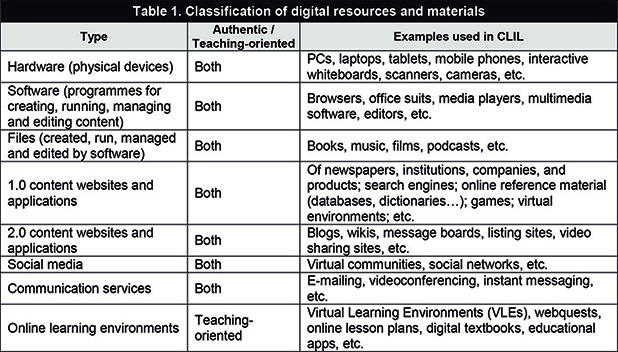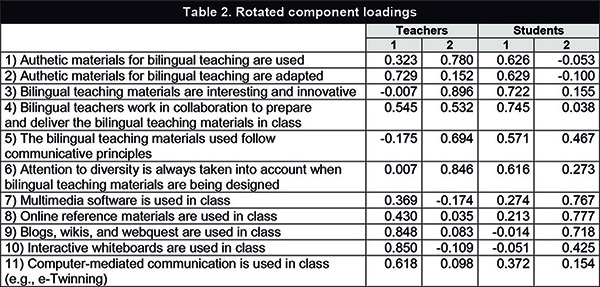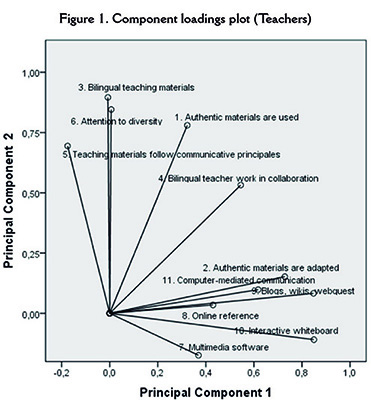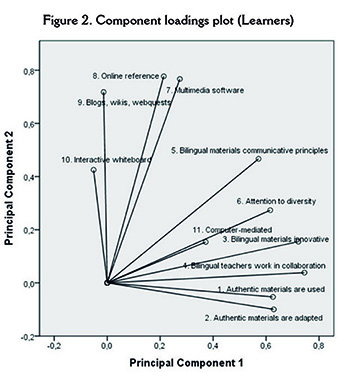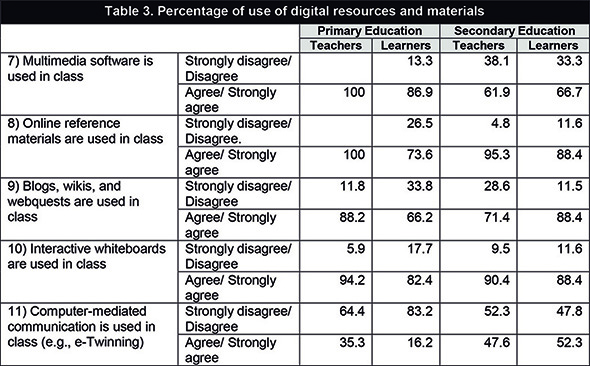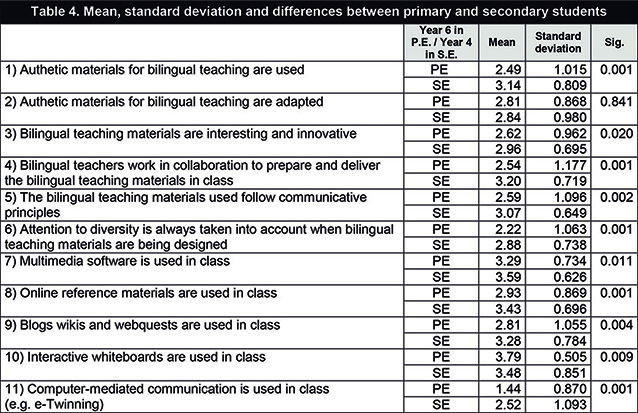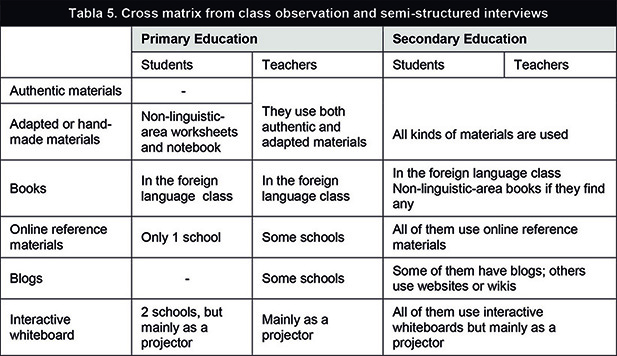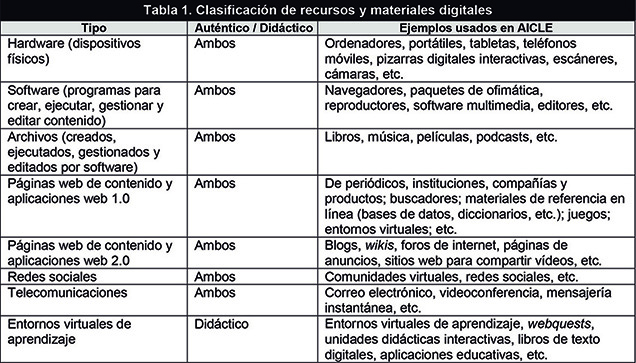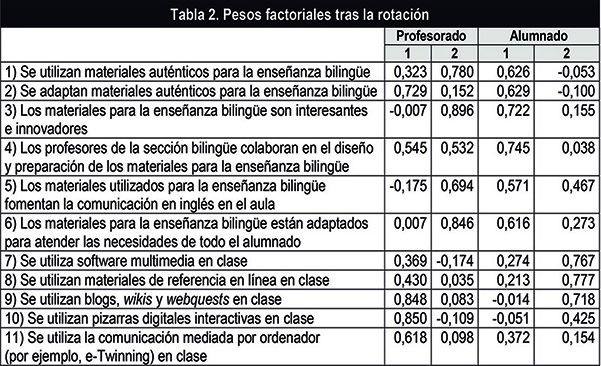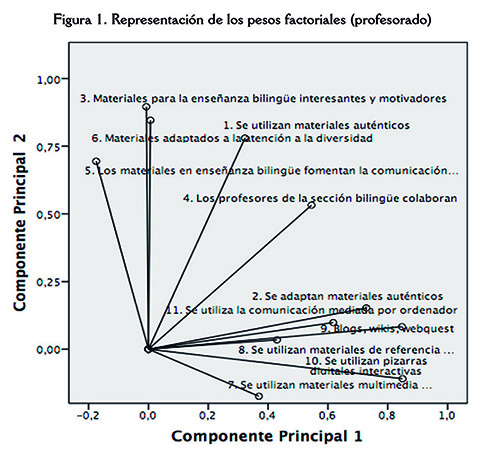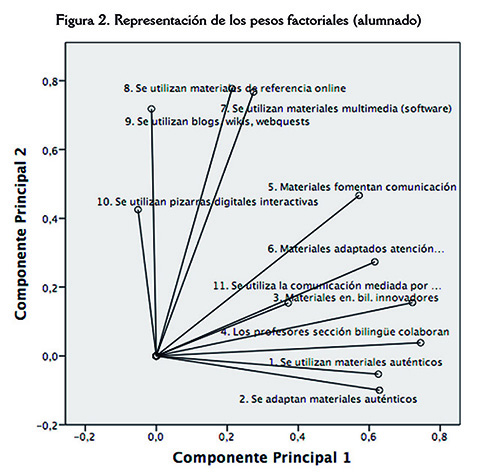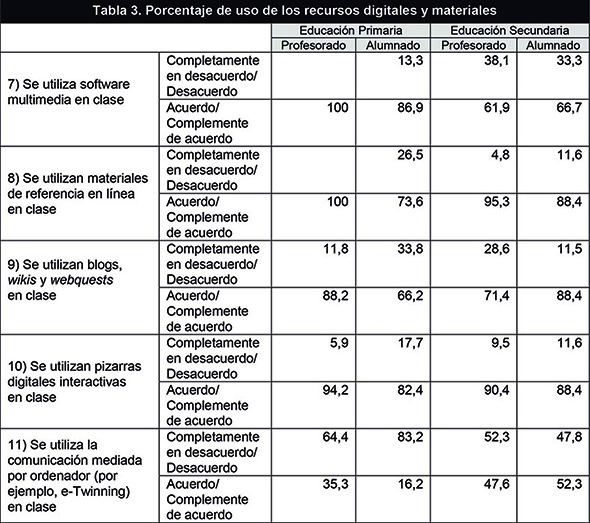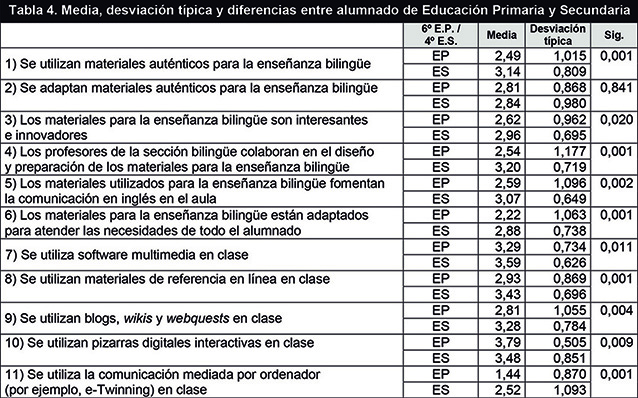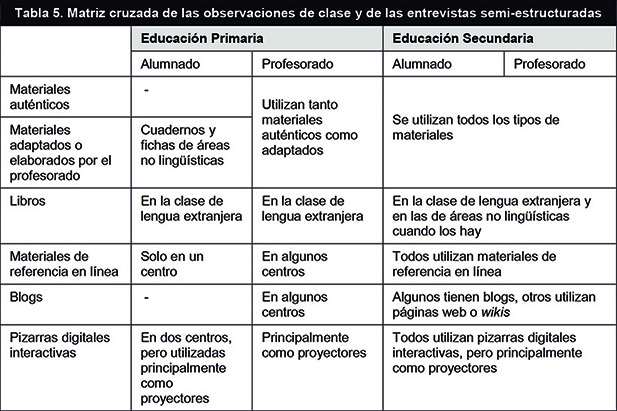Pulsa aquí para ver la versión en Español (ES)
Abstract
Research on the integration of digital resources and materials in CLIL contexts is still scant. This article presents the results of a study carried out in eight schools in the province of Seville. Questionnaires and interviews were used to collect the data regarding CLIL teachers' and learners' opinions on the intergration of digital resources and materials in the classroom. The aims of this study are: 1) To analyse teachers' and learners' perceptions on the integration of digital resources and materials in the CLIL classroom; 2) To analyse how the educational stage affects teachers' and learners' perceptions on this use; 3) To analyse the type of digital resources and materials in English that learners use outside the classroom. The following analyses have been carried out: Categorical Principal Components Analysis; Mann-Whitney U test; qualitative content analysis; finally, Pearson correlation coefficients were calculated. Results show that there are discrepancies between teachers' and learners' perceptions regarding the use of digital resources and materials in the classroom; and that these perceptions are affected by the educational stage. This study concludes that the type of resources and materials that learners use outside the classroom is determined by those used in the classroom. However, at home, they are used differently, which is indicative of the need to adapt classroom practices to learners’ own independent uses.
1. Introduction
Both CLIL (Content and Language Integrated Learning) and current methodologies in TEFL (Teaching English as a Foreign Language) fall under the umbrella category of the communicative approach. The communicative shift in language teaching began to take shape in the 1970s when theoretical configurations of linguistic competence (Chomsky, 1965) gave way to more encompassing notions of linguistic proficiency in terms of communicative competence (Hymes, 1972). As part of this new approach, new methodologies and programmes based on communicative principles started to emerge. These included content-based instruction, task-based language teaching, language immersion, bilingual and multilingual programmes, and CLIL (Dalton-Puffer 2011, 2014; Ruiz-de-Zarobe, Sierra, & Gallardo, 2011).
Coyle, Hood, and Marsh (2010) defined CLIL as “an educational approach in which various language-supportive methodologies are used which lead to a dual-focused form of instruction where attention is given both to the language and the content” (p. 3). Due to this dual focus through which both linguistic and non-linguistic contents are integrated into the teaching-learning process, CLIL shares some of the principles of communicative language teaching. Indeed, in Coyle’s 4Cs model, communication is, together with content, culture, and cognition, a central aspect of CLIL, as language is used not only as a means of instruction but as a tool to communicate and build knowledge on non-linguistic content. In this process, knowledge is also built around non-linguistic content (Coyle, 2002). Communication in CLIL implies engaging in tasks that meet the following criteria:
1) Tasks must be real: that is, they must replicate what we do with language outside the classroom.
2) Tasks must be purposeful: that is, language use must have a purpose or function.
At the same time, tasks that are truly communicative have three features in common (Larsen-Freeman & Anderson 2000):
1) Information gap: this occurs when one of the interlocutors knows something the other interlocutor does not, and therefore, contributes to filling an information gap.
2) Choice: this refers to the interlocutors’ freedom to decide what to say and how to say it.
3) Feedback: this implies that feedback from the interlocutor is required in order to know whether communication has happened.
When one or more of these requirements are not met, communication is not taking place.
In this scenario, the very conceptualisation of communication and communicative competence (the ultimate aim of language teaching and learning -Council of Europe, 2001) makes the CLIL classroom a suitable place for the use of ICTs, as these communicative situations and tasks may be easily reproduced and successfully performed through the use of digital media. Furthermore, digital resources and materials allow for a greater variety of contexts and interlocutors, which are needed so that real and purposeful communication may take place in the classroom.
1.1. Digital resources and materials in CLIL
The use of adequate resources and materials is key to successful teaching and learning: considered in a broad sense (Tomlinson, 1998), they are the mediators between learners and the reality that is the object of study (Manrique & Gallego, 2013). In the case of CLIL, it is through these resources and materials that students gain access to both language and content.
The very characteristics of CLIL described above suggest a methodological preference for the use of digital resources and materials over analogue ones. This is further reinforced by the fact that CLIL’s emergence in the 1990s (Pérez-Cañado, 2012; Fernández-Sanjurjo, Fernández-Costales, & Arias, 2017) coincided with the proliferation and popularisation of digital tools and media in education and elsewhere (Henderson & Romeo, 2015). Indeed, the theoretical bases of CLIL rely on, either implicitly or explicitly, on an understanding of the teaching-learning process as mediated by, or even happening in, the digital world (Coyle, 1999; Cummins, 1998). However, the real inclusion of digital resources and materials as an integral part of a whole CLIL pedagogy that fosters learner autonomy, knowledge building, interpersonal communication and collaborative work in the classroom is still far from being realised. The literature also indicates that there is a shortage of CLIL materials capable of linking theory and practice (Fernández-Fontecha, 2012). Table 1 provides a tentative classification of digital resources and materials commonly used in CLIL.
While it is widely acknowledged that the use of these resources and materials per se does not necessarily entail a methodological shift, their potential for transforming educational paradigms is usually recognised (Fernández-Fontecha, 2006, 2012). Thus, in order for this transformation to take place, digital resources and materials must be seen and used, not in an instrumental way (i.e. as tools), but rather as pathways for building knowledge, or loci for experiencing learning (Lesmes, Rodríguez, & Naranjo, 2010; Merchant, Burnett, & Parry, 2017).
At the same time, it has been argued that, because education is, above all, a communicative process (Martín-Barbero, 2006), it must be necessarily affected by the new ways in which we communicate through digital technologies. These changes refer especially to the development of new ways of thinking, analysing, feeling and communicating that are also central to changes produced at the epistemological level (Lesmes, Rodríguez, & Naranjo, 2010). This idea is also supported by Wong, Chai, & Aw (2017), for whom the new forms of communication imply the need for a new learning paradigm. The development of these epistemological structures finds an appropriate environment in the integration of CLIL and digital resources and materials (Maggi, Cherubim, & García-Pascual, 2014) through the use of, for example, interactive (as opposed to passive) devices such as the interactive whiteboard, which allows for new ways of interacting with information; 2.0 content websites such as blogs and wikis, where knowledge is built collaboratively; synchronous and asynchronous forms of computer and mobile-mediated communication, through which interpersonal communication across time and space is made possible; and virtual environments such as virtual reality experiences and webquests, which promote learner autonomy.
While there is ample research on the use of digital resources and materials in regular TEFL courses in Secondary Education (Banegas, 2017; Fernández-Fontecha, 2006; Izquierdo, De-la-Cruz-Villegas, Aquino-Zúñiga, Sandoval-Caraveo, & García-Martínez, 2017; Marsh, 2010; Wong, Chai, & Aw, 2017), research focused on CLIL at primary level is scant. This is mainly due to the fact that CLIL is a fairly recent methodology. Early research on CLIL concerned itself with conceptualisations and characterisations of the methodology (Coyle, 2008; Coyle, Hood & Marsh, 2010; Dalton-Puffer, 2011; Pérez-Cañado, 2012). This was followed by research focused on measuring learners’ foreign language proficiency levels (Admiraal, Westhooff, & De Bot, 2006; Lasagabaster, 2008; Dalton-Puffer, 2011), as well as their mastery of specific communicative subcompetences, skills or systems (Lasagabaster, 2007; Nieto, 2016), and how these are affected by other variables such as contextual factors, individual learner characteristics or motivation (Lasagabaster, 2011; Fernández & Canga, 2014; Doiz & Lasagabaster, 2014; Sylvén & Thomson, 2015). It is only recently that attention has been drawn to CLIL resources and materials, with several studies providing descriptions of materials that can be used in CLIL classrooms, frameworks and guidelines for material design and evaluation, and specific examples of CLIL activities (Banegas, 2017; Ball, Kelly, & Clegg, 2015; Coyle, Hood, & Marsh, 2010; Fernández-Fontecha, 2012; Mehisto, 2012; Meyer, 2010; Moore & Lorenzo, 2007, 2015; Morton, 2013; Smit, 2007). All of these are indicative of a lack of CLIL materials. However, there are no studies on the real use and integration of digital resources and materials in CLIL classrooms, teachers’ and learners’ perceptions of this, and their use outside the school setting.
These are the aspects addressed in this study, which seeks to answer the following research questions:
• RQ1. How do teachers and students perceive the use of digital resources and materials in the CLIL classroom?
• RQ2. How does the educational stage (Primary and Secondary Education) affect teachers’ and learners’ perceptions of the use of these resources and materials?
• RQ3. What kind of digital resources and materials in English do CLIL learners use outside of school?
2. Methods
This article draws on data and findings from a larger research project, “The effects of Content and Language Integrated Learning in monolingual communities: A large-scale evaluation”. The present study was carried out in eight different schools (both urban and rural) in the province of Seville (Spain). The participants were the teachers and learners involved in CLIL programmes in these schools; these included foreign language (FL) teachers, non-linguistic area (NLA) teachers, language assistants, and students. A mixed methods approach was used, more specifically, a convergent parallel design (Creswell, 2014). Four data-collection techniques were used: (1) direct observation, in order to obtain information about the actual use of digital resources and materials in the classroom; (2) semi-structured interviews to explore teachers’ and learners’ opinions on the use of digital resources and materials and contrast the information collected by means of other techniques; (3) a general questionnaire in different versions for teachers and students, designed and validated in Spanish and English; and (4) an extramural exposition questionnarie to determine learners’ use of digital resources and materials outside the school setting. Both the general questionnaire and the interviews include opinion questions to explore the respondents’ thoughts and outlook on the CLIL resources and materials used in the classroom. The combination of all these techniques ensured that information was collected in an objective and uniform way. The quantitative analysis was based on the answers to the general questionnaire by 137 students and 38 teachers. The qualitative part of the study was based on the observation of 14 classes, and interviews with a total of 70 students and 24 teachers.
3. Analyses and results
The internal consistency of teachers’ and students’ questionnaires was detemined by calculating Cronbach’s alpha coefficient. In the questionnaire administered to teachers, this coefficient was 0.919 and, in the questionnaire applied to the student, it was 0.886. A Categorical Principal Components Analysis (CAPTCA) (rotation method: Varimax with Kaiser normalisation) was used to asses construct validity. This analysis also allowed us to reduce the information gathered from the questionnaires and to distinguish between teachers’ and learners’ perspectives. Finally, in order to contrast the differences between teachers’ and learners’ opinions both at a primary and secondary level, a Mann-Whitney U test was applied.
A content analysis was performed on data collected from direct classroom observation and teachers’ and students’ interviews. A cross matrix was created fom the analysis of the differences between FL and NLA teachers, both in Primary and Secondary Education. This qualitative analysis made it possible to contrast and interpret the quantitative data from the questionnaires. Finally, Pearson correlation coefficients were calculated to establish correlations among the different digital resources and materials that students used outside the classroom, again both at a primary and secondary level.
3.1. Perceptions of the use of digital resources and materials
Regarding the first research question, a CAPTCA analysis allowed us to reduce the information collected in the questionnaires and distinguish, for both teachers and students, two principal components that can explain the variability in respondents’ answers. CAPTCA is similar to principal component analysis (sometimes considered a factor extraction method in factor analysis) when data are measured using ordinal or interval scales. As Table 2 (next page) shows, component 1 in the teachers’ questionnaire (items 7, 8, 9, 10 and 11, which correspond to multimedia software; online reference materials; blogs, wikis and webquests; interactive whiteboards; and computer-mediated communication, respectively) and component 2 in the learners’ questionnaire (items 7, 8, 9 and 10) are almost identical. These components allowed us to identify those items that were explicitly related to the use of digital resources and materials and recognised as such by respondents. In the case of teachers, item 4 (collaboratively made bilingual teaching materials) did not fit this pattern, as it was associated with factorial weights in both components; this may be due to the fact that they assigned more importance to the collaborative element than to the type of materials that were generated; on the other hand, students clearly associated this item with the use of digital resources and materials in the classroom.
Figure 1 (next page) shows the spatial arrangement of these components: items associated with digital resources and materials on the one hand, and the rest of the items on the other. Component 1, located on the horizontal axis and with a wider range of scores, had somewhat higher saturation levels (variance explained=28.25%) for items referring to digital resources (see lower quadrants). On the contrary, the rest of the items are located in the upper quadrants, with lower saturation levels (variance explained=27.04%). These data show a clear distinction between digital materials and resources and other types of materials.
Figure 2 (next page) shows the spatial arrangement of the main components obtained from the CAPTCA based on learners’ responses. In this case, the spatial arrangement is an inversion of that shown in Figure 1. Thus, the highest saturation levels are located in the upper quadrants, corresponding to items that do not explicitly refer to digital resources and materials (explained variance=25.73%), whereas the lowest saturation levels appear in the lower quadrants (explained variance=20.40%). These correspond to items explicitly related to digital resources and materials. It is interesting to note that, as opposed to teachers, learners associated item 11 (computer-mediated communication) with items not expressly related to digital resources and materials.
These data indicate that, generally, both teachers and students identify and classify digital resources and materials in a similar way. However, differences are found in their interpretation of their frequency of use in the classroom, with teachers perceiving a higher frequency of use than learners. These differences seem to be due to respondents’ different knowledge of and experience in the use of digital resources and materials, which distinguishes between teachers and learners, and between ICT-trained and non-ICT trained teachers.
3.2. The effect of the educational stage on teachers’ and learners’ perceptions
With respect to the two educational stages under study, the data indicate that teachers’ and learners’ perceptions of the use of digital resources and materials differ at both primary and secondary level. In Primary Education, teachers’ means are generally higher (above 3) than those of students (below 3), except for item 1 (authentic materials), for which teachers’ mean is below 3, and item 11 (computer-mediated communication), for which teachers’ mean is below 3 and students’ mean below 2. As Table 3 shows, if we consider only the items explicitly related to digital resources and materials, items 7, 8 and 10 (multimedia software; online reference materials; and interactive whiteboards, respectively) obtain similar percentages, with higher values for teachers (100%, 100% and 94.2% respectively) and lower values for learners (86.9%, 73.6% and 82.4% respectively). Both groups agree that the resources and materials in item 9 (blogs, wikis, and webquests) are used less in the classroom (88.2% for teachers and 66.2% for learners). Similarly, these data show that item 11 (computer-mediated communication) is rarely used (35.2% for teachers and 16.2% for students).
In Secondary Education, there is a higher degree of concurrence between teachers’ and learners’ responses. The means for most items exceed 3, except for items 9 and 11. In the case of learners, mean values are, in general, above 3, with the exception of items 2, 3 and 11. Again, Table 3 shows the percentage of use of digital resources and materials only: item 8 (online reference materials) is the most widely used resource (95.3% for teachers and 88.4% for learners), followed by item 10 (interactive whiteboards), which, according to 90.4% of teachers and 88.4% of students are used in class. Again, as in Primary Education, respondents report less use of resources and materials in item 9, but in this case, the percentage for teachers is even lower than that of learners (71.4% and 88.4% respectively). Finally, agreements between teachers’ and students’ perceptions are found when considering item 7 (61.9% for teachers and 66.7% for students) and item 11 (47.6% of teachers and 52.3% of students).
The most notable differences between results in Primary and Secondary Education were found when analysing learners’ opinions. Table 4 shows the results of the Mann-Whitney U test. It reveals statistically significant differences in the opinions of primary and secondary learners: secondary students report significantly more frequent use of digital resources and materials in English outside the school setting than primary learners. The only exception is item 2 (adapted authentic materials), where no statistically significant differences were found between primary and secondary students; this is probably due to differences in interpretation of the item, as learners may not have a clear picture of what adapted materials may be.
Now, regarding the opinions of teachers at both educational levels, no statistically significant differences were shown in the data, except for items 2 and 3 (adapted authentic materials and innovative bilingual materials). Likewise, the opinions of FL and NLA teachers were also not significantly different in terms of their perception on the use of resources and materials, with the exception of item 7 (multimedia software), which was most used by FL teachers.
In spite of the differences between teachers and learners, there were some similarities in respondents’ answers if we take into account only the digital resources and materials: most respondents agreed that items 8 and 10 (online reference materials and interactive whiteboards) are more frequently used than items 9 and 11 (blogs, wikis and webquests, and computer-mediated communication). The information provided by the quantitative data was supported by the information provided by the qualitative data obtained through classroom observation and interviews. Table 5 summarizes these qualitative data.
The information obtained in the interviews showed that both authentic and adapted materials are used in CLIL. Books are mainly used for FL classes and some NLA ones. In general, teachers stated that there are not enough resources available for CLIL delivery. Some schools do use online resources, both at primary and secondary levels. Students in Primary Education indicated that they do not use blogs, wikis or webquests, although teachers stated that they are used in the classroom. In Secondary Education, both teachers and students agreed on some use of blogs, wikis, and webquests. Finally, the interactive whiteboardis used, but most respondents coincided that these are mainly used as projectors.
3.3. Learners’ out-of-school use of digital resources and materials in English
In relation to the last research question, the questionnaires on extramural exposition provided information on the number of hours learners spend on English language activities outside of school and the digital resources they use. At the primary level, video games and songs are the most widely used. Primary school students also do other activities such as watching TV shows and films, reading books and magazines, but they devote fewer hours to these. In Secondary Education, listening to songs is the activity done by most respondents. Other activities to which they devote an important amount of time are the Internet and videogames. Finally, they spend fewer hours watching TV shows, reading books and magazines, and watching films.
There are positive and statistically significant correlations between these resources and materials. Table 6 (https://figshare.com/s/4cc23be1ec9a1bb5f917) illustrates the correlations between the different types of resources and materials that primary learners use in English outside of school. Interestingly, there is a positive and statistically significant correlation between internet use and a variety of activities (reading books, watching films and listening to songs). These correlations may indicate that when students access the Internet, they do so mainly to read digital books, watch films and listen to music online. Table 7 shows the correlations between the resources and materials used by Secondary Education students outside school (https://figshare.com/s/4cc23be1ec9a1bb5f917). As in Primary Education, there are positive and statistically significant correlations between internet use and other activities. In this case, their use of the Internet seems to be closely related to listening to songs, playing videogames, reading magazines and reading books.
All this is indicative that, even if the type of resources and materials that learners use outside the school is determined by those used in the classroom, new forms of access to the FL, and therefore, new ways of learning are developing through learners’ independent uses at home. These uses afford them opportunities for non-segmented and non-graded access to the FL, which differs greatly from the kind of exposure that they receive in the classroom.
4. Discussion and conclusions
This article provides a detailed analysis of the use of digital resources and materials in the CLIL classroom as well as of learners’ own independent uses outside the school setting, filling a gap in the burgeoning field of CLIL studies and of digital media in language education. As a main contribution, this study brings to the fore the need to adapt classroom practices to learners’ out-of-school use and experience of digital resources and materials. Concerning the first research question regarding teachers’ and learners’ perceptions on the use of digital resources and materials, both teachers and students grouped these in a similar way: items related to digital resources and materials on the one hand and the rest of the items on the other. However, results regarding their use in the classroom varied, with teachers acknowledging a much higher use of digital resources and materials than students. There are discrepancies between what teachers and students perceived as high or low use of digital resources and materials in the classroom. This may be due to the fact that they have different knowledge of and experience in the use of these resources and materials. Furthermore, in the case of teachers, lack of training may also account for these discrepancies. When undertrained teachers make use of these resources and materials, they tend to focus on the medium, and not so much on the contents to be delivered, as the medium takes up too much of their time and energy. Therefore, teachers’ perceptions of their use might be affected by these psychological factors. This is in accord with what previous research says about undertrained teachers using digital technologies (Scrivener, 2011).
From all this, it may be concluded that respondents’ identification of the types of resources and materials is not an issue at stake here, but rather the interpretation that each group makes of their frequency of use. In this regard, the main contribution of this study to the field is that respondents’ varying interpretations are determined mostly by their experience of these resources and materials, which tends to discriminate between teachers and learners on the one hand, and between ICT-trained and non-ICT-trained teachers on the other. Moreover, it seems that novice teachers’ experience and use of this kind of resources and materials is closer to that of learners, probably due to more similar patterns of independent access outside of school and, possibly, training. Further research on the contextual determinants of teachers’ and learners’ experience would be needed to shed light on their perception of the frequency of use of digital resources and materials in the classroom.
In relation to the second research question, when the sample is differentiated according to the educational stage, the data indicated that respondents’ opinions differ regarding the use of digital resources and materials. The most notable differences were found in the learners’ responses. This may be due to variations in the implementation of the CLIL approach, depending on the learners’ needs at each educational stage.
Another variable that may have an effect on this is teacher profile and training; factors also indicated in the literature (Izquierdo & al., 2017). However, common shortcomings in the use of these resources and materials in the two stages have also been identified. Results show that digital sources and materials more likely to, or specifically desiged to, foster collaborative knowledge building, interpersonal communication and learner autonomy (2.0 content websites such as blogs and wikis; social media such as virtual communities; communication services, such as e-mailing and instant messaging; and online learning environments, such as virtual learning environments and webquests) are the least used by teachers, both at primary and secondary level.
Furthermore, even if they make use of devices that could enhance these aspects (for example, the interactive whiteboard), in the classroom these serve the function of analogue devices (i.e., projectors). This is in accord with previous findings regarding traditional uses of digital resources and materials (Fernández-Fontecha, 2006; Izquierdo & al., 2017). As the teachers themselves indicated in the interviews, this may be because there are not enough digital materials available for bilingual teaching, a result that also supports previous findings, as mentioned above. However, as this study shows, it may not only be a question of lacking specific materials for CLIL but of the difficulties entailed in acknowledging and adequately utilising the opportunities that digital resources offer to set up spaces for interaction and process thinking. Further research into teachers’ knowledge of and experience in the use of these resources may provide an insight into these difficulties.
Finally, concerning the last research question, the results of the analyses conducted on the type of resources and materials in English that students use outside of school revealed that songs and videogames are the most widely used in both stages. The most important finding of this analysis was the existence of significant correlations between the activities. These correlations show that, at both levels, learners use the Internet to access reading materials and to listen to songs; primary learners also use it for watching films, while secondary learners use it for playing videogames.
These results indicate that students at both levels have an ongoing interest in using digital resources and materials in English outside of school. Furthermore, these uses replicate those that take place in the classroom, which demonstrates that these resources and materials are helpful in promoting and connecting both formal and informal learning experiences, giving rise to what is known as “seamless learning” (Wong, Chai, & Aw, 2017). This means that what is learned in the classroom does not stay there, but rather is recontextualised continuously and enriched by new uses in real communicative interactions in a variety of contexts and with a variety of interlocutors.
However, the full potential of these processes of recontextualisation is still far from being realised. Whereas the digital resources and materials used in and outside the classroom are the same, the activities in which learners engage in the classroom are passive (reception of knowledge) and offer segmented, graded and decontextualised access to the FL. This contrasts with the kind of activities in which learners engage outside the school setting, where activities are and afford them acess to the FL in a non-segmented and non-graded, more communicative and contextualised way. The main conclusion to be drawn from this is that, in order to adequately exploit the teaching and communicative potential of digital resources and materials for CLIL, these should be used in ways that resemble more closely the ways learners interact with information and access the FL outside of school. These ways are also more communicatively and socially relevant and have a greater potential to foster collaborative knowledge building, interpersonal communication, and learner autonomy. It is necessary to incorporate these aspects in order to help bridge the distance between formal and informal access to knowledge and to truly integrate digital resources and materials in the classroom in accordance with CLIL principles.
References
Ball, P., Kelly, K., & Clegg, J. (2015). Putting CLIL into practice. Oxford: Oxford University Press. https://doi.org/10.1075/jicb.5.1.07gie
Banegas, D.L. (2017). Teacher developed materials for CLIL: Frameworks, sources, and activities. Asian EFL Journal, 19(3), 31-48. https://bit.ly/2SJqoxU
Chomsky, N. (1965). Aspects of the theory of syntax. Cambridge: The MIT Press. https://doi.org/10.21236/ad0616323
Coyle, D. (1999). Theory and planning for effective classrooms: supporting students in content and language integrated learning contexts. In J. Masih (Ed.), Learning through a foreign language (pp.46-62). London: CILT.
Coyle, D. (2002). Relevance of CLIL to the European Commission’s Language. In D. Marsh (Ed.), CLIL/EMILE. The European dimension. Actions, trends, and foresight potential (pp. 1-25). Córdoba: Universidad de Córdoba.
Coyle, D. (2008). CLIL - A pedagogical approach. In N. Van-Deusen-Scholl, & N. Hornberger (Eds.), Encyclopedia of language and education (pp. 97-111). New York: Springer. https://doi.org/10.1007/978-0-387-30424-3_92
Coyle, D., Hood, P., & Marsh, D. (2010). CLIL: Content and language Integrated Learning. Cambridge: Cambridge University Press.
Creswell, J.W. (2014). Research design: Qualitative, Quantitative and mixed methods approaches. Thousand Oaks, CA: Sage.
Cummins, J. (1998). Immersion education for the millennium: What have we learned from 30 years of research on second language immersion? In M.R. Childs, & R.M. Bostwick (Eds.) Learning through two languages: Research and practice. Second Katoh Gakuen International Symposium on Immersion and Bilingual Education (pp. 34-47). Japan: Katoh Gakuen.
Dalton-Puffer, C. (2011). Content and Language integrated learning: From practice to principles? Annual Review of Applied Linguistic. https://doi.org/10.1080/09571736.2014.891370
Dalton-Puffer, C. (2014). You can stand under my umbrella: Immersion, CLIL and bilingual education. A response to Cenoz, Genesee and Gorter (2013). Applied Linguistics, 35(2), 213-218. https://doi.org/10.1093/applin/amu010
Fernández-Fontecha, A. (2006). The design of ICT materials for L2 teaching: state of the art. Interlingüística, 17, 333-344. https://bit.ly/2PyPjSM
Fernández-Fontecha, A. (2012). CLIL in the foreign language classroom: Proposal of a framework for ICT materials design in language-oriented versions of content and language integrated learning. Alicante Journal of English Studies, 25, 317334. https://doi.org/10.14198/raei.2012.25.22
Fernández-Sanjurjo, J., Fernández-Costales, A., & Arias, J. (2017). Analysing students’ content-learning in science in CLIL vs. Non-CLIL programmes: empirical evidence from Spain. International Journal of Bilingual Education and Bilingualism. https://doi.org/10.1080/13670050.2017.1294142
Henderson, M., & Romeo, G. (eds.) (2015). Teaching and digital technologies. Cambridge: Cambridge University Press.
Izquierdo, J., De-la-Cruz-Villegas, V., Aquino-Zúñiga, S.P., Sandoval-Caraveo, M.C., & García-Martínez, V. (2017). Teachers’ Use of ICTs in public language education: Evidence from second language secondary-school Classrooms. [La enseñanza de lenguas extranjeras y el empleo de las TIC en las escuelas secundarias públicas]. Comunicar, 25(50), 33-41. https://doi.org/10.3916/C50-2017-03
Larsen-Freeman, D., & Anderson, M. (2000). Techniques and Principles in Language Teaching. Oxford: Oxford University Press. https://doi.org/10.2307/328245
Lesmes-Sáenz, L.A., Rodríguez-Roncancio, E., & Naranjo-Colorado, L.D. (2010). TIC y educación: Los medios digitales en la educación. Congreso Iberoamericano de Educación. Metas 2021. Buenos Aires, 13-14 and 15 of September, 2010.
Maggi, F., Cherubim, M., & García-Pascual, E. (2014). Using Web 2.0 tools in CLIL. In S. Garton, & K. Graves (Eds.), International perspectives on materials in ELT. Basingstoke: Palgrave Macmillan. https://doi.org/10.1057/9781137023315.0021
Manrique-Orozco, A.M., & Gallego-Henao, A.M. (2013). El material didáctico para la construcción de aprendizajes significativos. Revista Colombiana de Ciencias Sociales, 4(1), 101-108. https://bit.ly/2zTmSKw
Marsh, J. (2010). Young children’s play in online virtual worlds. Journal of Early Childhood Research 8(1), 23-39. https://doi.org/10.1177/1476718X09345406
Martín-Barbero, J. (2006). La educación desde la comunicación. Bogotá: Norma.
Mehisto, P. (2012). Criteria for producing CLIL learning material. Encuentro 21(1), 15-33. https://bit.ly/2Ld7EnX
Meyer, O. (2010). Towards quality-CLIL: Successful planning and teaching strategies. Pulso 33, 11-29. https://bit.ly/2rAn2Ss
Moore, P., & Lorenzo, F. (2007). Adapting authentic materials for CLIL classrooms: An empirical study. Vienna English Working Papers, 16(3), 28-35. https://bit.ly/2EjCCcO
Moore, P., & Lorenzo, F. (2015). Task-Based learning and content and language integrated learning materials design. Process and product. Language Learning Journal, 43(3), 334-357. https://doi.org/10.1080/09571736.2015.1053282
Morton, T. (2013). Critically evaluating materials for CLIL: Practitioners’ practices and perspectives. In J. Gray (Ed.), Critical perspectives on language teaching materials (pp.111-136). Basignstoke: Palgrave Macmillan. https://doi.org/10.1057/9781137384263_6
Pérez-Cañado, M. (2012). CLIL research in Europe: Past, present and future. International Journal of Bilingual Education and Bilingualism 15(3), 315-341. https://doi.org/10.1080/13670050.2011.630064
Ruiz-de-Zarobe, Y., Sierra., J., & Gallardo, F. (2011). Content and foreign language integrated learning. Contributions to multilinguals in European contexts. Berna: Peter Lang. https://doi.org/10.3726/978-3-0351-0171-3
Scrivener, J. (2011). Learning Teaching. London: Macmillan.
Smit, H. (2007). Free teaching materials for CLIL lessons. In B. Roza-González (Ed.). Good practice in content and language integrated learning (pp. 67-69). Gijón: BeCLIL,
Tomlinson, B. (ed.) (1998). Materials development in language teaching. Cambridge: Cambridge University Press.
Wong, L.H., Chai, C.S., & Aw, G.P. (2017). Seamless language learning: Second language learning with social media. [Aprendizaje de idiomas ‘sin costuras’: Aprendizaje de segundas lenguas y redes sociales. Comunicar, 50(25), 9-21. https://doi.org/10.3916/C50-2017-01
Click to see the English version (EN)
Resumen
La investigación sobre la integración de recursos y materiales digitales en contextos AICLE es todavía escasa. Este trabajo presenta los resultados obtenidos en ocho centros de la provincia de Sevilla, donde se han recogido las opiniones de alumnado y profesorado AICLE a través de cuestionarios y entrevistas. Los objetivos del estudio son: 1) Analizar las opiniones de los participantes sobre la integración de los recursos y materiales digitales en el aula; 2) Analizar cómo afecta la etapa educativa a las opiniones de ambos grupos; 3) Analizar el tipo de recursos y materiales digitales en lengua inglesa que utiliza el alumnado fuera del aula. Se han llevado a cabo los siguientes análisis: análisis de componentes principales categóricos; prueba no paramétrica U de Mann-Whitney; análisis de contenido; y se ha calculado el coeficiente de correlación de Pearson. Los resultados muestran discrepancias en las percepciones de profesorado y alumnado con respecto al uso de los recursos y materiales digitales en el aula; y que estas percepciones se ven afectadas por la etapa educativa. Este estudio concluye que el tipo de recursos que utiliza el alumnado fuera del aula está condicionado por el uso que se hace de ellos dentro de la misma. Sin embargo, en casa se utilizan de manera diferente, lo que revela la necesidad de adaptar las prácticas de aula a los usos autónomos del alumnado.
1. Introducción
Tanto AICLE (Aprendizaje Integrado de Contenidos y Lengua Extranjera) como las actuales metodologías para la enseñanza del inglés como lengua extranjera se enmarcan dentro del enfoque comunicativo de la enseñanza de lenguas. El giro comunicativo en la enseñanza de lenguas comenzó en los años setenta del pasado siglo cuando el concepto de competencia lingüística (Chomsky, 1965) fue sustituido por nociones más amplias como la competencia comunicativa (Hymes, 1972). En este nuevo período comenzaron a surgir nuevas metodologías y programas de enseñanza basados en principios comunicativos, entre ellos, el aprendizaje basado en tareas, la enseñanza por proyectos, los programas de inmersión lingüística, los programas bilingües y multilingües y, también, la metodología AICLE (Dalton-Puffer 2011, 2014; Ruiz-de-Zarobe, Sierra, & Gallardo, 2011).
Coyle, Hood y Marsh (2010) han definido AICLE como un doble enfoque educativo que combina diversas metodologías para la enseñanza tanto de la lengua como del contenido no lingüístico. Debido a este doble enfoque a través del cual se integran contenidos lingüísticos y no lingüísticos en el proceso de enseñanza-aprendizaje, AICLE comparte algunos de los principios de la enseñanza comunicativa de las lenguas. De hecho, en el modelo de las «cuatro ces» de Coyle, la comunicación es, junto con los contenidos, la cultura y los aspectos cognitivos, un pilar de la metodología AICLE, donde la lengua se utiliza, no solo como medio de instrucción, sino como herramienta para comunicar y construir conocimiento sobre contenidos no lingüísticos (Coyle, 2002). El principio de la comunicación en AICLE implica la realización de tareas que cumplen con los siguientes requisitos:
1) Las tareas deben ser reales: esto es, deben replicar tareas para las que utilizamos la lengua fuera del aula.
2) Las tareas deben tener un propósito y ser significativas: esto es, en estas tareas, la lengua debe tener una función y un significado concreto dentro de un determinado contexto comunicativo.
Asimismo, las tareas comunicativas comparten tres características principales (Larsen-Freeman & Anderson 2000):
1) Vacío de información: se produce cuando el mensaje transmitido no es conocido por quien lo recibe, de manera que la comunicación contribuye a llenar un vacío de información.
2) Elección: se refiere a la libertad de quien comunica para decidir qué decir y cómo decirlo.
3) Retroalimentación: implica la necesidad de una respuesta o reacción para confirmar que se ha producido la comunicación.
La comunicación no ocurre si una o más de estas características no se cumplen.
De este modo, la propia conceptualización de la comunicación y de la competencia comunicativa (el objetivo principal de la enseñanza y aprendizaje de idiomas) (Council of Europe, 2001) hace que el aula AICLE se convierta en el lugar idóneo para el uso de las tecnologías de la información y la comunicación (TIC), dado que los medios digitales permiten recrear fácilmente estas situaciones y tareas comunicativas. Es más, los recursos y materiales digitales proporcionan una mayor variedad de contextos e interlocutores, los cuales son necesarios para que la comunicación real y significativa tenga lugar en el aula.
1.1. Los recursos y materiales digitales en AICLE
El uso de recursos y materiales apropiados es central para asegurar el éxito del proceso de enseñanza-aprendizaje. Considerados de manera general (Tomlinson, 1998), los recursos y materiales median entre quienes aprenden y la realidad que es el objeto de estudio (Manrique & Gallego, 2013); en el caso de AICLE, el alumnado accede tanto a la lengua como a los contenidos no lingüísticos a través de estos recursos y materiales. Las propias características de AICLE, descritas anteriormente, parecen indicar una preferencia metodológica por el uso de recursos y materiales digitales más que analógicos, una idea que viene reforzada por la coincidencia temporal, en los años noventa del siglo pasado, de la aparición de la metodología AICLE (Pérez-Cañado, 2012; Fernández-Sanjurjo, Fernández-Costales, & Arias, 2017) y la proliferación y popularización de las herramientas y medios digitales, tanto en educación como en otras esferas de la vida cotidiana (Henderson & Romeo, 2015).
De hecho, las teorías sobre AICLE se basan, de manera implícita o explícita, en una conceptualización de la educación como un proceso que está mediado por, o incluso que tiene lugar en, el mundo digital (Coyle, 1999; Cummins, 1998). Sin embargo, aún no se ha conseguido la integración real de los recursos y materiales digitales como parte integral de toda una pedagogía AICLE que fomenta la autonomía del alumnado, la construcción de conocimiento, la comunicación interpersonal y el trabajo colaborativo en el aula. Además, la literatura también indica que no hay suficientes materiales AICLE capaces de aunar teoría y práctica (Fernández-Fontecha, 2012). La Tabla 1 proporciona una clasificación provisional de los recursos y materiales digitales utilizados frecuentemente en AICLE.
Si bien el uso de estos recursos y materiales, en sí mismo, no supone necesariamente un cambio metodológico, en la literatura se reconoce su potencial para transformar los paradigmas educativos (Fernández-Fontecha, 2006, 2012); para que esta transformación tenga lugar, los recursos y materiales digitales deben ser concebidos y utilizados, no como instrumentos o herramientas, sino como lugares para experimentar la construcción del conocimiento y el aprendizaje (Lesmes, Rodríguez, & Naranjo, 2010; Merchant, Burnett, & Parry, 2017).
Del mismo modo, también se ha argumentando que la educación, en tanto que proceso eminentemente comunicativo (Martín-Barbero, 2006), se ha visto afectada por las nuevas maneras en que nos comunicamos hoy día gracias a las tecnologías digitales. Estos cambios guardan especial relación con el desarrollo de «nuevas lógicas de pensamiento [...], maneras de analizar, reflexionar, concluir, sentir y expresar» (Lesmes, Rodríguez, & Naranjo, 2010: 10), que son también centrales para los cambios producidos a nivel epistemológico, una idea que comparten Wong, Chai y Aw (2017), para quienes las nuevas formas de comunicación han de dar lugar a un nuevo paradigma de enseñanza. En algunos casos, incluso se considera que la combinación de la metodología AICLE con una integración real de recursos y materiales digitales proporciona el entorno más apropiado para el desarrollo de estas nuevas estructuras epistemológicas (Maggi, Cherubim, & García-Pascual, 2014). Esto se consigue gracias al uso de, por ejemplo, dispositivos interactivos (en contraposición a los pasivos), como la pizarra digital interactiva, que proporcionan nuevas maneras de interactuar con la información; las páginas web 2.0, como los blogs y las wikis, donde se construye conocimiento colaborativamente; las formas de comunicación sincrónica y asincrónica por móvil y ordenador, que hacen posible la comunicación interpersonal salvando fronteras de tiempo y espacio; y los entornos virtuales, como las experiencias de realidad virtual y los webquests, que promueven el aprendizaje autónomo.
Aunque se ha investigado profusamente sobre el uso de recursos y materiales digitales en el aula de inglés como lengua extranjera, sobre todo en Educación Secundaria (Banegas, 2017; Fernández-Fontecha, 2006; Izquierdo, De-la-Cruz-Villegas, Aquino-Zúñiga, Sandoval-Caraveo, & García-Martínez, 2017; Marsh, 2010; Wong, Chai, & Aw, 2017), las investigaciones sobre el uso de estos recursos en AICLE en Educación Primaria son todavía escasas. Esto se debe principalmente al hecho de que AICLE es una metodología relativamente reciente.
Las primeras investigaciones sobre AICLE se ocuparon, principalmente, de conceptualizar y caracterizar esta metodología (Coyle, 2008; Coyle, Hood, & Marsh, 2010; Dalton-Puffer, 2011; Pérez-Cañado, 2012). Posteriormente, los estudios se centraron en el desarrollo de la lengua extranjera del alumnado en programas bilingües (Admiraal, Westhooff, & De Bot, 2006; Lasagabaster, 2008; Dalton-Puffer, 2011), así como en su dominio de subcompetencias comunicativas específicas, determinadas habilidades y sistemas lingüísticos (Lasagabaster, 2007; Nieto, 2016), y el efecto que otras variables como los factores contextuales, las características propias del alumnado o la motivación podían tener en su desarrollo lingüístico (Lasagabaster, 2011; Fernández & Canga, 2014; Doiz & Lasagabaster, 2014; Sylvén & Thomson, 2015).
Más recientemente, han surgido investigaciones que coinciden en la escasez de recursos y materiales específicos de AICLE. Se trata de estudios que proporcionan marcos y directrices para el diseño y evaluación de materiales, descripciones de materiales y ejemplos específicos de actividades AICLE (Banegas, 2017; Ball, Kelly, & Clegg, 2015; Coyle, Hood, & Marsh, 2010; Fernández-Fontecha, 2012; Mehisto, 2012; Meyer, 2010; Moore & Lorenzo, 2007, 2015; Morton, 2013; Smit, 2007). Sin embargo, y a pesar de este interés reciente, no hay investigaciones centradas en el uso real e integración de los recursos y materiales digitales en el aula AICLE, las percepciones del profesorado y el alumnado, y el uso de estos recursos y materiales por parte del alumnado fuera del aula.
Estos son los aspectos que se abordan en el presente estudio, que busca responder las siguientes preguntas de investigación:
• PI1. ¿Cómo percibe el profesorado y el alumnado AICLE el uso de los recursos y materiales digitales en el aula?
• PI2. ¿Qué efecto tiene el nivel educativo (Educación Primaria y Secundaria) en estas percepciones?
• PI3. ¿Qué tipo de recursos y materiales digitales en inglés utiliza el alumnado AICLE fuera del aula?
2. Métodos
Este artículo se basa en los datos y resultados obtenidos en un proyecto de investigación más amplio titulado «Los efectos del Aprendizaje Integrado de Contenidos y Lenguas Extranjeras en comunidades monolingües: un estudio longitudinal». El presente estudio se ha llevado a cabo en ocho centros educativos bilingües (tanto urbanos como rurales) de la provincia de Sevilla (España). Los sujetos que participan en la investigación son el alumnado y el profesorado de las secciones bilingües; dentro de este último grupo, participa tanto profesorado de lengua extranjera (LE) como profesorado de áreas no lingüísticas (ANL) y auxiliares de conversación.
Se ha utilizado un método mixto de investigación con un diseño convergente paralelo (Creswell, 2014). La recogida de datos se apoyó en cuatro procedimientos: 1) Observación directa, utilizada con el fin de obtener información sobre el uso real de los recursos y materiales digitales en el aula; 2) Entrevistas semiestructuradas, para conocer las percepciones del profesorado y el alumnado sobre el uso de recursos y materiales digitales, y contrastar la información recopilada mediante otras técnicas; 3) Un cuestionario general en diferentes versiones para profesorado y alumnado, diseñado y validado en español e inglés; 4) Un cuestionario de exposición extramural para determinar el uso que hace el alumnado de los recursos y materiales digitales en inglés fuera del entorno escolar. Tanto el cuestionario general como las entrevistas incluyen preguntas de opinión para explorar las percepciones de los participantes sobre los recursos y materiales AICLE utilizados en el aula. La combinación de todas estas técnicas garantiza el contraste de la información recogida. El análisis cuantitativo se centró en las respuestas al cuestionario general y al cuestionario de exposición extramural de 137 discentes y 38 docentes. Por su parte, el análisis cualitativo abordó la observación de 14 clases y entrevistas con un total de 70 discentes y 24 docentes.
3. Análisis y resultados
La consistencia interna de los cuestionarios completados por profesorado y alumnado se determinó mediante el cálculo del coeficiente alfa de Cronbach. En el cuestionario administrado a docentes se obtuvo un coeficiente de 0,919 y, en el cuestionario aplicado al alumnado, el valor de dicho cofienciente fue de 0,886. La validez de constructo de los cuestionarios se determinó mediante un Análisis de Componentes Principales Categóricos (CAPTCA), utilizando la rotación Varimax con normalización de Kaiser como método de rotación. Este análisis también permitió reducir la información recopilada a partir de los cuestionarios y diferenciar entre las perspectivas aportadas por profesorado y alumnado. Finalmente, para contrastar las diferencias entre las opiniones de docentes y discentes, tanto en Educación Primaria como Secundaria, se aplicó la prueba U de Mann-Whitney.
Se realizó un análisis de contenido de los datos recopilados a partir de la observación directa en el aula y las entrevistas realizadas a profesorado y alumnado. Se elaboró una matriz cruzada para el análisis de las diferencias entre profesorado de LE y ANL, en Primaria y Secundaria. Este análisis cualitativo permitió contrastar e interpretar la información recogida en las preguntas abiertas de los cuestionarios. Finalmente, se calculó el coeficiente de correlación de Pearson para establecer las relaciones entre los recursos y materiales digitales en inglés que el alumnado utiliza fuera del aula, en las dos etapas educativas consideradas.
3.1. Percepciones sobre el uso de materiales y recursos digitales
Con respecto a la primera pregunta de investigación, un análisis CAPTCA permitió reducir la información recopilada en los cuestionarios y distinguir dos componentes principales que pueden explicar la variabilidad en las respuestas de profesorado y alumnado. El análisis CAPTCA es similar al análisis de componentes principales (también se considera un método de extracción en el análisis factorial) y se utiliza cuando los datos se miden en escalas ordinales o de intervalo. Como se muestra en la Tabla 2, el Componente 1 en el cuestionario para profesorado (ítems 7, 8, 9, 10 y 11, que corresponden a software multimedia; materiales de referencia en línea; blogs, wikis y webquests; pizarras digitales interactivas; y comunicación por ordenador, respectivamente) y el Componente 2 en el cuestionario del alumnado (ítems 7, 8, 9 y 10) son similares. Estos componentes nos permiten identificar aquellos elementos que están explícitamente relacionados con el uso de recursos y materiales digitales, y que los encuestados reconocen como tal.
En el caso del profesorado, el ítem 4 (materiales diseñados de forma colaborativa) no se ajusta a este patrón, ya que se asocia con ponderaciones factoriales en ambos componentes; esto puede deberse al hecho de que el profesorado concede más importancia al elemento de colaboración que al tipo de materiales que se generan; por otro lado, el alumnado asocia claramente este elemento al uso de recursos y materiales digitales en el aula.
La Figura 1 muestra la distribución espacial de los dos componentes según las opiniones del profesorado: elementos asociados con recursos y materiales digitales, por un lado, y elementos no relacionados con dichos recursos y materiales por otro. El Componente 1, ubicado en el eje horizontal y con un rango más amplio de puntajes, tiene niveles de saturación algo más altos (varianza explicada=28,25%) para los ítems que se refieren a recursos digitales (ver cuadrantes inferiores). Por el contrario, el resto de los ítems se ubican en los cuadrantes superiores con niveles de saturación más bajos (varianza explicada=27,04%). Estos datos muestran una clara distinción entre las valoraciones relacionadas, por un lado, con los materiales y recursos digitales y, por otro lado, con otros tipos de materiales.
La Figura 2 muestra la disposición espacial de los componentes principales obtenidos en el CAPTCA en función de las respuestas del alumnado. En este caso, la disposición espacial es una inversión de la que se muestra en la Figura 1. Así, los ítems con niveles de saturación más altos se ubican en los cuadrantes superiores, que no se refieren explícitamente a los recursos y materiales digitales (varianza explicada=25,73%), mientras que los niveles de saturación más bajos se corresponden con los cuadrantes inferiores y corresponden a los ítems explícitamente relacionados con los recursos y materiales digitales (varianza explicada=20,40%). Es interesante observar que, a diferencia del profesorado, el alumnado asocia el ítem 11 (comunicación mediada por ordenador) con ítems que no están expresamente relacionados con los recursos y materiales digitales.
Estos datos indican que, en general, tanto docentes como discentes identifican y clasifican los recursos y materiales digitales de manera similar. Sin embargo, se encuentran diferencias en la interpretación de su frecuencia de uso en el aula, de manera que el profesorado considera que se utilizan con mayor frecuencia que el alumnado. Estas diferencias podrían explicarse desde el distinto conocimiento y experiencia que ambos grupos tienen de los recursos y materiales digitales, que distingue entre profesorado y alumnado, por un lado, y entre profesorado con y sin formación en el uso de TIC, por el otro.
3.2. El efecto de la etapa educativa en las percepciones de profesorado y alumnado
Con relación a las dos etapas educativas objeto de estudio, los datos indican que las percepciones de profesorado y alumnado sobre el uso de recursos y materiales digitales difieren tanto en Primaria como en Secundaria. En Educación Primaria, las puntuaciones medias del profesorado son generalmente más altas (por encima de 3) que las del alumnado (por debajo de 3), a excepción del ítem 1 (materiales auténticos), para el que la puntuación media del profesorado es inferior a 3, y el ítem 11 (comunicación mediada por ordenador), para el que la puntuación media del profesorado es inferior a 3 y, la del alumnado, inferior a 2.
Como muestra la Tabla 3, si se consideran solo los ítems relacionados explícitamente con los recursos y materiales digitales, los ítems 7, 8 y 10 (software multimedia; materiales de referencia en línea; y pizarras digitales interactivas, respectivamente) obtienen porcentajes similares, con valores más altos para el profesorado (100%, 100% y 94,2% respectivamente) y más bajos el alumnado (86,9%, 73,6% y 82,4% respectivamente). Ambos grupos están de acuerdo en que los recursos y materiales a los que se refiere el ítem 9 (blogs, wikis y webquests) se utilizan menos en el aula (88,2% para el profesorado y 66,2% para el alumnado). Por último, estos datos muestran que el ítem 11 (comunicación mediada por ordenador) rara vez se usa (35,2% para el profesorado y 16,2% para el alumnado).
En Educación Secundaria se observa una mayor correspondencia entre las respuestas de docentes y discentes. Las puntuaciones medias para la mayoría de los ítems superan los 3 puntos, excepto en los ítems 9 y 11. En el caso del alumnado, las puntuaciones medias son, en general, superiores a 3, con la excepción de los ítems 2, 3 y 11. La Tabla 3 muestra el porcentaje de uso de los recursos y materiales digitales solamente: el ítem 8 (materiales de referencia en línea) es el recurso más utilizado en clase (95,3% para el profesorado y 88,4% para el alumnado), seguido del ítem 10 (pizarras digitales interactivas), que se utiliza en clase según el 90,4% del profesorado y el 88,4% del alumnado.
Al igual que en Educación Primaria, los encuestados informan de un menor uso de los recursos y materiales a los que se refiere el ítem 9, pero en este caso el porcentaje para el profesorado es incluso más bajo que para alumnado (71,4% y 88,4% respectivamente). Finalmente, existe cierto acuerdo entre las percepciones de profesorado y alumnado al considerar los ítems 7 (61,9% del profesorado y 66,7% del alumnado) y 11 (47,6% del profesorado y 52,3% del alumnado).
Las diferencias más destacables entre los resultados obtenidos en la comparación entre Primaria y Secundaria se encuentran al analizar las opiniones del alumnado. La Tabla 4 (página siguiente) muestra los resultados de la prueba U de Mann-Whitney. Esta prueba revela diferencias estadísticamente significativas en las opiniones del alumnado en ambos niveles educativos: el alumnado de Secundaria informa de un uso de los recursos y materiales digitales en inglés fuera del entorno escolar significativamente más frecuente que el alumnado de Primaria. La única excepción es el ítem 2 (materiales auténticos adaptados), en el que no se encuentran diferencias estadísticamente significativas entre el alumnado de ambas etapas; esto se debe probablemente a las diferencias en la interpretación del ítem, ya que es posible que el alumnado no tenga una idea clara de lo que son los materiales adaptados.
Con respecto a las opiniones del profesorado en ambas etapas educativas, no se han encontrado diferencias estadísticamente significativas, a excepción de los ítems 2 y 3 (materiales auténticos adaptados y materiales bilingües innovadores). Del mismo modo, las opiniones del profesorado de LE y ANL tampoco son significativamente diferentes respecto a su percepción sobre el uso de recursos y materiales, con la excepción del ítem 7 (software multimedia), que es el más utilizado por el profesorado de LE.
A pesar de las diferencias profesorado y alumnado, hay algunas similitudes en sus respuestas si tenemos en cuenta los ítems referidos a los recursos y materiales digitales: la mayoría de los encuestados está de acuerdo en que los ítems 8 y 10 (materiales de referencia en línea y pizarras digitales interactivas) se utilizan con más frecuencia que los ítems 9 y 11 (blogs, wikis y webquests; y comunicación mediada por ordenador, respectivamente). La información proporcionada por los datos cuantitativos está respaldada por los datos cualitativos obtenidos a través de las observaciones en el aula y las entrevistas. La Tabla 5 (página 91) resume estos datos cualitativos.
La información obtenida en las entrevistas muestra que, en AICLE, se utilizan tanto materiales auténticos como adaptados. Los libros se utilizan principalmente en las clases de inglés como lengua extranjera, y solo en algunas clases de materias no lingüísticas. En general, el profesorado coincide en que no hay suficientes recursos disponibles para AICLE. Algunos centros sí utilizan recursos en línea, tanto en Primaria como en Secundaria: el alumnado de Primaria indica que no usan blogs, wikis o webquests, aunque el profesorado afirma lo contrario. En Educación Secundaria, tanto el profesorado como el alumnado está de acuerdo en que se hace un uso esporádico de blogs, wikis y webquests. Finalmente, la mayoría de los encuestados coincide en que la pizarra digital interactiva sí se utiliza, pero principalmente como proyector.
3.3. Uso de los recursos y materiales digitales en inglés fuera del aula
En relación con la última pregunta de investigación, los cuestionarios sobre la exposición extramural proporcionan información sobre la cantidad de horas que el alumnado emplea en actividades en inglés fuera del centro educativo, y los recursos digitales que utiliza. En Educación Primaria, jugar a videojuegos y escuchar canciones son las actividades más comunes. El alumnado de dicha etapa también realiza otras actividades como ver programas de televisión y películas, y leer libros y revistas, aunque dedica menos tiempo a estas últimas.
En Educación Secundaria, escuchar canciones es una actividad que realiza la mayoría del alumnado encuestado. Otras actividades a las que se dedica una cantidad importante de tiempo son navegar en Internet y jugar a videojuegos. Finalmente, el alumnado de Secundaria pasa menos horas viendo programas de televisión, leyendo libros y revistas, y viendo películas.
Se han identificado correlaciones positivas y estadísticamente significativas entre estos recursos y materiales. La Tabla 6 (https://figshare.com/s/4cc23be1ec9a1bb5f917) ilustra las correlaciones entre los diferentes tipos de recursos y materiales en inglés que el alumnado de Primaria utiliza fuera de la escuela. Merece destacarse que existe una correlación positiva y estadísticamente significativa entre el uso de Internet y una variedad de actividades como leer libros, ver películas y escuchar canciones en inglés. Estas correlaciones pueden indicar que cuando el alumnado utiliza Internet lo hace principalmente para leer libros digitales, ver películas y escuchar música en línea.
La Tabla 7 muestra las correlaciones entre los recursos y los materiales utilizados por el alumnado de Educación Secundaria fuera del aula (https://figshare.com/s/4cc23be1ec9a1bb5f917). Al igual que en Primaria, existen correlaciones positivas y estadísticamente significativas entre el uso de Internet y otras actividades, en este caso, escuchar canciones, jugar a videojuegos, y leer revistas y libros. Todo ello parece indicar que, si bien los recursos y materiales que el alumnado utiliza fuera del aula vienen determinados por aquellos utilizados dentro de la misma, están surgiendo nuevas maneras de acceder a la lengua extranjera fuera del entorno escolar y, por tanto, se están desarrollando nuevas formas de aprendizaje autónomo. Estos usos independientes que el alumnado realiza de estos recursos y materiales fuera del aula están proporcionando oportunidades de acceso no segmentado y no adaptado a la lengua extranjera, lo que difiere enormemente del tipo de exposición que reciben en el aula.
4. Discusión y conclusiones
Este artículo proporciona un análisis detallado del uso de los recursos y materiales digitales en el aula AICLE, así como de los usos independientes del alumnado fuera del entorno escolar, llenando un vacío en el creciente campo de los estudios sobre la implementación de la metodología AICLE y sobre los medios digitales en la enseñanza de lenguas. Como contribución principal, este estudio pone de relieve la necesidad de adaptar las prácticas de aula al conocimiento y experiencia que el alumnado tiene de estos recursos y materiales fuera de la misma.
Con respecto a la primera pregunta de investigación, relacionada con las percepciones sobre los recursos y materiales digitales en el aula, tanto el profesorado como el alumnado los agrupan de manera similar: por un lado, los elementos relacionados con recursos y materiales digitales y, por otro, el resto de elementos. Sin embargo, los resultados con respecto a su uso en el aula varían, ya que el profesorado reconoce un uso mucho mayor de los recursos y materiales digitales que el alumnado. Por tanto, se observan discrepancias entre lo que el profesorado y el alumnado percibe como un uso elevado o bajo de los recursos y materiales digitales en el aula. Ello puede deberse al hecho de que ambos grupos tienen diferente conocimiento y experiencia de estos recursos y materiales.
Asimismo, en el caso del profesorado, la falta de formación también podría explicar estas discrepancias. Cuando el profesorado con menos formación o experiencia hace uso de estos recursos y materiales, tiende a centrarse en el medio, y no tanto en el contenido a impartir, ya que el medio le requiere más tiempo y energía. De este modo, la percepción del profesorado sobre su uso puede verse afectada por estos factores psicológicos. Esto concuerda con los resultados de estudios anteriores sobre el uso que el profesorado con escasa formación en TIC hace de las tecnologías digitales (Scrivener, 2011). De todo esto se puede concluir que la principal discrepancia entre profesorado y alumnado no se encuentra en la identificación de los tipos de recursos y materiales, sino en la interpretación que cada grupo hace de su frecuencia de uso. En este sentido, la mayor contribución de esta investigación al campo de estudio es que las diferentes interpretaciones de los encuestados están determinadas principalmente por su conocimiento y experiencia de estos recursos y materiales, que tiende a discriminar entre profesorado y alumnado, por un lado, y entre profesorado con y sin formación en TIC, por el otro.
Además, parece que la experiencia y el uso de este tipo de recursos y materiales por parte del profesorado novel es más cercana a la del alumnado, probablemente debido a patrones muy parecidos de acceso independiente fuera del aula y, posiblemente, a su formación. Es necesario investigar más sobre los factores contextuales que determinan la experiencia del profesorado y el alumnado para conocer más acerca de sus percepciones de la frecuencia de uso de los recursos y materiales digitales en el aula.
En relación con la segunda pregunta de investigación, cuando la muestra se diferencia según la etapa educativa, los resultados indican que las opiniones de los encuestados difieren con respecto al uso de los recursos y materiales digitales. Las diferencias más notables se encuentran en las respuestas del alumnado. Esto puede deberse a variaciones en la implementación de la metodología AICLE, dependiendo de las necesidades del alumnado en cada etapa educativa.
Otra variable que puede incidir en ello es el perfil y la formación del profesorado, factores también señalados en la literatura (Izquierdo & al., 2017). Sin embargo, también se han detectado limitaciones comunes en el uso de estos recursos y materiales en las dos etapas. Los resultados muestran que los recursos y materiales digitales que con mayor probabilidad fomentan, o están diseñados para fomentar, la construcción colaborativa de conocimiento, la comunicación interpersonal y la autonomía del alumnado (páginas web de contenido 2.0 como blogs y wikis; redes sociales como comunidades virtuales; servicios de telecomunicación, como el correo electrónico y la mensajería instantánea; y los entornos de aprendizaje en línea, como los entornos de aprendizaje virtual y los webquests) son los menos utilizados por el profesorado, tanto en Educación Primaria como en Educación Secundaria.
Además, incluso cuando en el aula se hace uso de dispositivos que podrían fomentar estos aspectos (por ejemplo, la pizarra digital interactiva), estos cumplen la función de los dispositivos analógicos (es decir, se utilizan como proyectores). Esto concuerda con los hallazgos de estudios anteriores sobre los usos tradicionales de los recursos y materiales digitales (Fernández-Fontecha, 2006; Izquierdo & al., 2017). Como el propio profesorado apunta en las entrevistas, esto puede deberse a que no hay suficientes materiales digitales disponibles para la enseñanza bilingüe, un resultado que, como se ha mencionado anteriormente, también respalda hallazgos anteriores.
Sin embargo, como muestra este estudio, es posible que no solo se trate de la falta de materiales específicos para AICLE, sino de la dificultad que entraña poder identificar y explotar adecuadamente las oportunidades que los recursos y materiales digitales ofrecen para configurar espacios para la interacción y el aprendizaje procedimental. De nuevo, es necesario investigar más sobre el conocimiento y la experiencia que el profesorado tiene del uso de estos recursos para comprender mejor estas dificultades.
Por último, con respecto a la última pregunta de investigación, los resultados de los análisis realizados sobre los recursos y materiales en inglés que el alumando utiliza fuera del aula revelan que las canciones y los videojuegos son los más utilizados en ambas etapas educativas. El hallazgo más importante de este análisis es la existencia de correlaciones significativas entre las actividades que se realizan. Estas correlaciones muestran que, en ambos niveles, el alumnado utiliza Internet para leer libros y revistas y para escuchar canciones; el alumnado de Primaria también lo usa para ver películas y, el alumnado de Secundaria, para jugar a videojuegos. Estos resultados indican que el alumnado de ambas etapas educativas tiene interés por el uso de recursos y materiales digitales en inglés fuera del aula.
Además, estos usos independientes reproducen ciertos patrones de uso que tienen lugar en el aula, lo que demuestra el potencial de los recursos y materiales digitales para conectar los aprendizajes formales e informales, dando lugar a lo que se conoce como «aprendizaje sin costuras» (Wong, Chai, & Aw, 2017). Esto quiere decir que lo que se aprende en el aula no permanece allí, sino que se recontextualiza y enriquece constantemente, mediante nuevos usos en interacciones comunicativas reales en diferentes contextos y con diferentes interlocutores. Sin embargo, todo este potencial recontextualizador aún no se está aprovechando. Mientras que los recursos y materiales digitales utilizados dentro y fuera del aula son los mismos, las actividades que se realizan en el aula son pasivas (recepción de conocimientos) y ofrecen un acceso segmentado, adaptado y descontextualizado a la lengua extranjera.
Por el contrario, fuera del aula, el alumnado accede a la lengua extranjera de un modo no segmentado y no adaptado, y en contextos más reales y comunicativos. La principal conclusión que se puede extraer de esto es que, si se desea explotar adecuadamente el potencial didáctico y comunicativo de los recursos y materiales digitales para AICLE, estos deben utilizarse de un modo que se asemeje más a la forma en que el alumnado interactúa con la información y accede a la lengua extranjera fuera del aula: se trata de usos que tienen mayor relevancia, tanto comunicativa como social, y un mayor potencial para fomentar la construcción colaborativa de conocimiento, la comunicación interpersonal y la autonomía del alumnado. Se hace, por tanto, necesaria la incorporación de estos aspectos para conseguir conectar los aprendizajes formales e informales e integrar verdaderamente el uso de los recursos y materiales digitales en el aula de acuerdo con los principios de la metodología AICLE.
Referencias
Ball, P., Kelly, K., & Clegg, J. (2015). Putting CLIL into practice. Oxford: Oxford University Press. https://doi.org/10.1075/jicb.5.1.07gie
Banegas, D.L. (2017). Teacher developed materials for CLIL: Frameworks, sources, and activities. Asian EFL Journal, 19(3), 31-48. https://bit.ly/2SJqoxU
Chomsky, N. (1965). Aspects of the theory of syntax. Cambridge: The MIT Press. https://doi.org/10.21236/ad0616323
Coyle, D. (1999). Theory and planning for effective classrooms: supporting students in content and language integrated learning contexts. In J. Masih (Ed.), Learning through a foreign language (pp.46-62). London: CILT.
Coyle, D. (2002). Relevance of CLIL to the European Commission’s Language. In D. Marsh (Ed.), CLIL/EMILE. The European dimension. Actions, trends, and foresight potential (pp. 1-25). Córdoba: Universidad de Córdoba.
Coyle, D. (2008). CLIL - A pedagogical approach. In N. Van-Deusen-Scholl, & N. Hornberger (Eds.), Encyclopedia of language and education (pp. 97-111). New York: Springer. https://doi.org/10.1007/978-0-387-30424-3_92
Coyle, D., Hood, P., & Marsh, D. (2010). CLIL: Content and language Integrated Learning. Cambridge: Cambridge University Press.
Creswell, J.W. (2014). Research design: Qualitative, Quantitative and mixed methods approaches. Thousand Oaks, CA: Sage.
Cummins, J. (1998). Immersion education for the millennium: What have we learned from 30 years of research on second language immersion? In M.R. Childs, & R.M. Bostwick (Eds.) Learning through two languages: Research and practice. Second Katoh Gakuen International Symposium on Immersion and Bilingual Education (pp. 34-47). Japan: Katoh Gakuen.
Dalton-Puffer, C. (2011). Content and Language integrated learning: From practice to principles? Annual Review of Applied Linguistic. https://doi.org/10.1080/09571736.2014.891370
Dalton-Puffer, C. (2014). You can stand under my umbrella: Immersion, CLIL and bilingual education. A response to Cenoz, Genesee and Gorter (2013). Applied Linguistics, 35(2), 213-218. https://doi.org/10.1093/applin/amu010
Fernández-Fontecha, A. (2006). The design of ICT materials for L2 teaching: state of the art. Interlingüística, 17, 333-344. https://bit.ly/2PyPjSM
Fernández-Fontecha, A. (2012). CLIL in the foreign language classroom: Proposal of a framework for ICT materials design in language-oriented versions of content and language integrated learning. Alicante Journal of English Studies, 25, 317334. https://doi.org/10.14198/raei.2012.25.22
Fernández-Sanjurjo, J., Fernández-Costales, A., & Arias, J. (2017). Analysing students’ content-learning in science in CLIL vs. Non-CLIL programmes: empirical evidence from Spain. International Journal of Bilingual Education and Bilingualism. https://doi.org/10.1080/13670050.2017.1294142
Henderson, M., & Romeo, G. (eds.) (2015). Teaching and digital technologies. Cambridge: Cambridge University Press.
Izquierdo, J., De-la-Cruz-Villegas, V., Aquino-Zúñiga, S.P., Sandoval-Caraveo, M.C., & García-Martínez, V. (2017). Teachers’ Use of ICTs in public language education: Evidence from second language secondary-school Classrooms. [La enseñanza de lenguas extranjeras y el empleo de las TIC en las escuelas secundarias públicas]. Comunicar, 25(50), 33-41. https://doi.org/10.3916/C50-2017-03
Larsen-Freeman, D., & Anderson, M. (2000). Techniques and Principles in Language Teaching. Oxford: Oxford University Press. https://doi.org/10.2307/328245
Lesmes-Sáenz, L.A., Rodríguez-Roncancio, E., & Naranjo-Colorado, L.D. (2010). TIC y educación: Los medios digitales en la educación. Congreso Iberoamericano de Educación. Metas 2021. Buenos Aires, 13-14 and 15 of September, 2010.
Maggi, F., Cherubim, M., & García-Pascual, E. (2014). Using Web 2.0 tools in CLIL. In S. Garton, & K. Graves (Eds.), International perspectives on materials in ELT. Basingstoke: Palgrave Macmillan. https://doi.org/10.1057/9781137023315.0021
Manrique-Orozco, A.M., & Gallego-Henao, A.M. (2013). El material didáctico para la construcción de aprendizajes significativos. Revista Colombiana de Ciencias Sociales, 4(1), 101-108. https://bit.ly/2zTmSKw
Marsh, J. (2010). Young children’s play in online virtual worlds. Journal of Early Childhood Research 8(1), 23-39. https://doi.org/10.1177/1476718X09345406
Martín-Barbero, J. (2006). La educación desde la comunicación. Bogotá: Norma.
Mehisto, P. (2012). Criteria for producing CLIL learning material. Encuentro 21(1), 15-33. https://bit.ly/2Ld7EnX
Meyer, O. (2010). Towards quality-CLIL: Successful planning and teaching strategies. Pulso 33, 11-29. https://bit.ly/2rAn2Ss
Moore, P., & Lorenzo, F. (2007). Adapting authentic materials for CLIL classrooms: An empirical study. Vienna English Working Papers, 16(3), 28-35. https://bit.ly/2EjCCcO
Moore, P., & Lorenzo, F. (2015). Task-Based learning and content and language integrated learning materials design. Process and product. Language Learning Journal, 43(3), 334-357. https://doi.org/10.1080/09571736.2015.1053282
Morton, T. (2013). Critically evaluating materials for CLIL: Practitioners’ practices and perspectives. In J. Gray (Ed.), Critical perspectives on language teaching materials (pp.111-136). Basignstoke: Palgrave Macmillan. https://doi.org/10.1057/9781137384263_6
Pérez-Cañado, M. (2012). CLIL research in Europe: Past, present and future. International Journal of Bilingual Education and Bilingualism 15(3), 315-341. https://doi.org/10.1080/13670050.2011.630064
Ruiz-de-Zarobe, Y., Sierra., J., & Gallardo, F. (2011). Content and foreign language integrated learning. Contributions to multilinguals in European contexts. Berna: Peter Lang. https://doi.org/10.3726/978-3-0351-0171-3
Scrivener, J. (2011). Learning Teaching. London: Macmillan.
Smit, H. (2007). Free teaching materials for CLIL lessons. In B. Roza-González (Ed.). Good practice in content and language integrated learning (pp. 67-69). Gijón: BeCLIL,
Tomlinson, B. (ed.) (1998). Materials development in language teaching. Cambridge: Cambridge University Press.
Wong, L.H., Chai, C.S., & Aw, G.P. (2017). Seamless language learning: Second language learning with social media. [Aprendizaje de idiomas ‘sin costuras’: Aprendizaje de segundas lenguas y redes sociales. Comunicar, 50(25), 9-21. https://doi.org/10.3916/C50-2017-01
Document information
Published on 31/03/19
Accepted on 31/03/19
Submitted on 31/03/19
Volume 27, Issue 1, 2019
DOI: 10.3916/C59-2019-08
Licence: CC BY-NC-SA license
Share this document
Keywords
claim authorship
Are you one of the authors of this document?
